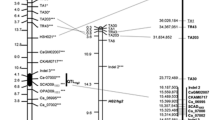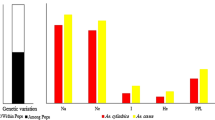Abstract
Aegilops tauschii line of spring type growth habit with theearliest heading among all the VIR world germplasm collection of thisspecies was crossed with three Ae. tauschii lines of winter type growthhabit with low, intermediate and the highest vernalization requirement. 12enzyme loci were involved in genetic analysis. The growth habit was foundto be encoded by single codominant major gene, Vrn-D2. Thefollowing linkages were found: Est5 – Nadhd2 in chromosome 3, Vrn-D2 – Aco2 – Cat2 and Pgm – Nadhd1 in chromosome 4, Est2 – Got2 in chromosome 6.
Similar content being viewed by others
References
Boyko, E.V., K.S. Gill & B.S. Gill, 1998. A high density genetic linkage map of the Aegilops tauschii genome and its application in wheat breeding. In: A.E. Sinkard (Ed.), Proc. 9th Int. Wheat Genetic Symp., Saskaton, Saskatchewan, Canada, v 2: 167-169.
Dubcovsky, J., D. Lijavetzky, L. Appendino & G. Tranquilli, 1998. Comparative RFLP mapping of Triticum monococcum genes controlling vernalization requirement. Theor Appl Genet 97: 968-975.
Dudnikov, A. Ju., 1998. Allozyme variation in Transcaucasian populations of Aegilops squarrosa. Heredity 80: 248-258.
Dudnikov, A. Ju., 2000. Multivariate analysis of genetic variation in Aegilops tauschii from the world germplasm collection. Genet Resour. and Crop Evol 47: 185-190.
Dudnikov, A. Ju, 2001. Chromosomal location of an esterase gene set (Est-10) of common wheat orthologous to Est5 of Aegilops tauschii. Cereal Res Commun 29: 57-60.
Gill, K.S., E.L. Lubbers, B.S. Gill, W.J. Raupp & T.S. Cox, 1991. A genetic linkage map of Triticum tauschii (DD) and its relationship to the D genome of bread wheat (AABBDD). Genome 34: 362-374.
Goncharov, N.P. & S.F. Koval, 1989: Genetic of an isogenic line of spring common wheat variety 'Novosibirskaya 67'. (1) Investigation of type of growth habit of an isogenic line ANK-18.Izvestiya Sibirskogo Otdeleniya Akademii Nauk SSSR, biological sciences series 1: 3-6 (in Russian).
Goncharov, N.P. & N.N. Chikida, 1995. Genetics of growth habit in Aegilops squarrosa L. Russian J Genet 3: 343-346.
Hart, G.E., 1983. Hexaploid wheat (Triticum aestivum L. em Thell). In: S.D. Tanksley & T.J. Orton (Eds.), Isozymes in Plant Genetics and Breeding, Part B, pp. 35-56. Elsevier Science Publishers B.V., Amsterdam.
Jaaska, V., 1980. Electrophoretic survey of seedling esterases in wheats in relation to their phylogeny. Theor Appl Genet 56: 273-284.
Jaaska, V., 1981. Aspartate aminotransferase and alcohol dehydrogenase isoenzymes: intraspecific differentiation in Aegilops tauschii and the origin of the D genome polyploids in the wheat group. Plant Syst Evol 137: 259-273.
Kimber, G. & M. Feldman, 1987. Wild Wheat. An Introduction. Special report 353. College of Agr. Univ. Missouri, Columbia, pp. 1-142.
Korzun, V., S. Malyshev, A. V. Voylokov, V. Smirnov & A. Borner, 2001. A genetic map of rye (Secale cereale L.). In: T.A. Pshenichnikova & A.J.Worland (Eds.), Proc. 11th EWAC Conf., 24-28, July, 2000, Novosibirsk, pp. 48-51.
Laurie, D.A., N. Pratchett, J.H. Bezant & J.W. Snape, 1995. RFLP mapping of five major genes and eight quantitative trait loci controlling flowering time in a winter × spring barley (Hordeum vulgare L.) cross. Genome 38: 575-585.
Lui, C.J. & M.D. Gale, 1991. The chromosomal location of genes encoding NADH dehydrogenase isozymes in hexaploid wheat and related species. Genome 34: 44-51.
McIntosh, R.A., G.E. Hart, K.M. Devos, M.D. Gale & W.J. Rogers, 1998. Catalogue of gene symbols for wheat. In: A.E. Sinkard (Ed.), Proc. 9th Int. Wheat Genetic Symp., Saskatoon, Saskatchewan, Canada, v 5, pp. 1-236.
Navruzbekov, N.A., 1989. Evolution of wheat genome and allopolyploidy. Vestnik selskohozyaistvennoy nauki 398: 78-84 (in Russian).
Nevo, E., A. Beiles, D. Kaplan, E.M. Golenberg, L. Olsvig-Whittaker & Z. Nuvez, 1986a. Natural selection of allozyme polymorphisms: a microsite test revealing ecological genetic differentiation in wild barley. Evolution 40: 13-20.
Nevo, E., D. Zohary, A. Beiles, D. Kaplan & N. Stroch, 1986b. Genetic diversity and environmental associations of wild barley, Hordeum spontaneum, in Turkey. Genetica 68: 203-213.
Nevo, E. & A. Beiles, 1989. Genetic diversity of wild emmer wheat in Israel and Turkey: structure, evolution and application in breeding. Theor Appl Genet 77: 421-455.
Nevo, E., I. Noy-Meir, A. Beiles, T. Krugman & M. Agamy, 1991. Natural selection of allozyme polymorphisms: microgeographical spatial and temporal ecological differentiations in wild emmer wheat. Israel J. Bot. 40: 419-450.
Porceddu, E. & D. Lafiandra, 1985. Origin and evolution of wheats. In: The Origin and Domestication of Cultivated Plants, Symp., Rome, November 25-27, pp. 143-178.
Powers, D.A., T. Lauerman, D. Crawford & L. DiMichele, 1991. Genetic mechanisms for adapting to a changing environment. Annu Rev Genet 25: 629-659.
Pugsley, A.T., 1971. A genetic analysis of the spring-winter habit of growth in wheat. Aust J Agric Res 22: 21-31.
Salina, E., A. Borner, I. Leonova, V. Korzun, L. Laikova, O. Maistrenko & M.S. Roder, 2000. Microsatellite mapping of the induced sphaerococcoid mutation genes in Triticum aestivum. Theor Appl Genet 100: 686-689.
Scandalios, J.G., 1994. Engineering organisms for tolerance to oxidative stress: the maize superoxide dismutases. In: C.L. Markert, J.G. Scandalios, H.L. Lim & O.L. Serov (Eds.), Isozymes: Organization and Roles in Evolution, Genetics and Physiology, pp. 23-57. World Scientific, Singapore, New Jersey, london, Hong Kong.
Snape, J.W., D.A. Laurie & A.J. Worland, 2000. Mapping and comparative mapping of flowering time genes in wheat. In: Abstracts of the 11th EWAC Conf., 24-28 July, 2000, Novosibirsk, p. 14.
Stuber, C.W., 1989. Marker-based selection for quantitative traits. Vortr Pflanzenzuchtg 16: 31-49.
Tanaka, M., 1983. Geographical distribution of Aegilops species based on the collections at the plant germplasm institute. Kyoto University. In: Proc. 6th Int. Wheat Genet Symp., Kyoto, Japan, pp. 1009-1024.
Thiele, V. & A. Seidel, 1990. Chromosomal location of a catalase gene in wheat using rye-wheat-additions. Plant Breeding 105: 78-79.
Zhukovsky, P.M., 1928. A critical-systematical survey of the species of the genus Aegilops L. Bull Appl Bot, Genet Plant Breed 18: 417-609 (in Russian).
Author information
Authors and Affiliations
Rights and permissions
About this article
Cite this article
Dudnikov, A.J. Allozymes and growth habit of Aegilops tauschii: genetic control and linkage patterns. Euphytica 129, 89–97 (2003). https://doi.org/10.1023/A:1021558628874
Issue Date:
DOI: https://doi.org/10.1023/A:1021558628874




